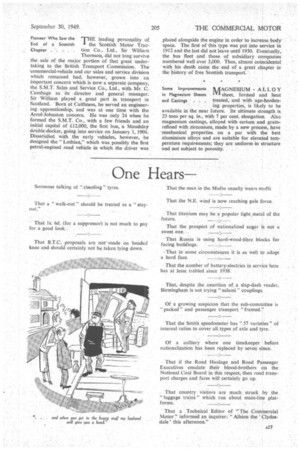Steel-sprayed Lenses qamE industrial works for Anti-glare S OME
Page 28

Page 29

If you've noticed an error in this article please click here to report it so we can fix it.
as well as the
Glasses driving of vehicles, -require
continuous or interrupted use of eye protection from glare A recently introduced process for the production of "sun glasses" consists in spraying the glass with metallic vapour of stainless steel in a scientifically " gradient " pattern of density and area. Glass so treated is stated to be superior to that in use for such purposes.
Party from I.R.T.E A RECENT visit of 35 Pays Visit to Shell "members of the Institute Haven of Road Transport Engineers was to the refinery of the Shell Refining arid Marketing Co., Ltd., at Shell Haven. They were accompanied by many members of the staff of Shell-Mex and B.P., Ltd. From the London Division were Mr. A. T. Hunt (deputy. manager), Mr. T. James, Mr. T. H. Lewis and Mr. A. Moon (all assistant managers), whilst from head office came Mr. G. W. Todd, Mr. F. Lawrence, Mr. J. P. Gaudin and Mr. M. Mothio, whilst the installation manager, Mr. Masters, joined at lunch. The huge refinery consists essentially of two plants, both of which use as feedstock a crude oil from which the lighter fractions have been removed., in the earlier plant, the yield from a naphthenic crude is oils for industrial purposes and bitumen, both straight and oxidized. In the new section, a paraffinic crude is subjected to a solvent-refining process to yield high-grade motor. lubricants, paraffin wax and other products. Close by is a site for a huge new refinary which, in a .few years, will produce a whole range of petroleum products, including motor spirit, 'from Middle. East crude oil.
Efforts to Av.o id A'Penn, Bucks, represen
Interference with tatives of nine transport Television . . undertakings in the Midlands
and other interests recently attended a demonstration of the effects of motor vehicle ignition on television, and were shown how' these can be ,obviated. At a point some 24 miles from Alexandra Palace a single dipole aerial was erected, and on the television set the picture was clear. When a car was started near, white spots passed across the screen and speech was marred by a pulsating sound. The fitting of a resister, costing' Is. 6d., into the ignition distributor cap eliminated these effects in a few seconds. A farm tractor caused worse interference, which was similarly obviated. The demonstration was staged by the British Radio Equipment Manufacturers Association. Pioneer Who Saw the 'THE leading personality of End of a Scottish A the Scottish Motor Trac Chapter tion Co.. Ltd., Sir William Thomson, did not long survive the sale of the major portion of that great undertaking to the British Transport Commission. The commercial-vehicle and car sales and service division which remained had, however, grown into an important concern which is now a separate company, the S.M.T. Sales and Service Co., Ltd., with Mr. C. Cambage as its director and general manager. Sir William played a great part in transport in Scotland. Born• at Caithness, he served an engineering apprenticeship, and was at one time with the Arrol-Johnstott concern. He was only 24 when he formed the S.M.T. Co., with a few friends and an initial capital of £12,000, the first bus, a Maudslay double-decker, going into service on January 1, 1906. Dissatisfied with the early vehicles, however, he designed the Lothian," which was possibly the first petrol-engined road vehicle in which the driver was placed alongside the engine in order to increase body space. The first of this type was put into service in 1912 and the last did not leave until 1930. Eventually, the bus fleet and those of subsidiary companies numbered well over 3,000. Thus, almost coincidental with his death came the end of a great chapter in the history of free Scottish transport.
Some Improvements MAGNESIUM ALLOY in Magnesium Sheets nrit sheet, formed and heat and Castings . . . treated, and with age-harden ing properties, is likely to be available in the near future. Its ultimate strength is 23 tons per sq. in., with 7 per cent. elongation. Also magnesitun castings, alloyed with, cerium and grainrefined with zirconium, made by a new process, have mechanical properties on a par with the best aluminium alloys and are suitable for elevated temperature requirements; they are uniform in structure and not subject to porosity. _




















































































